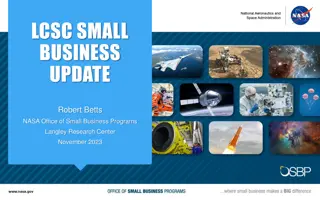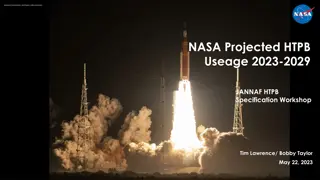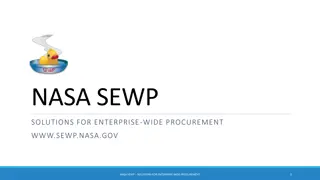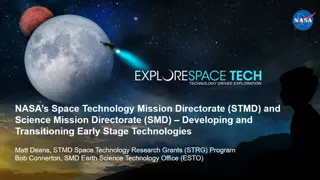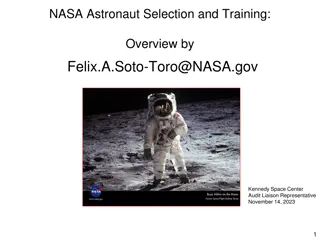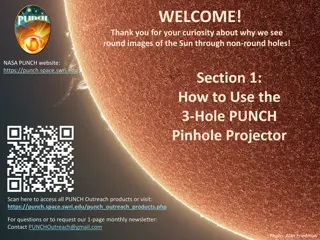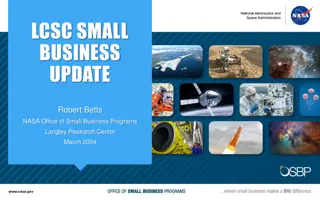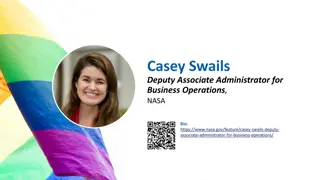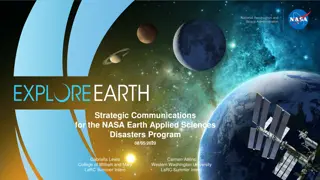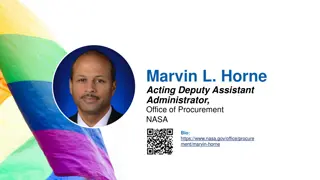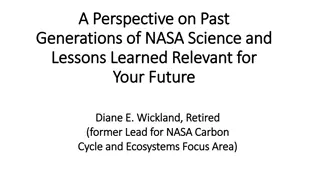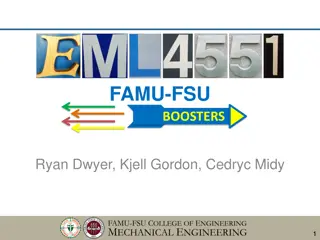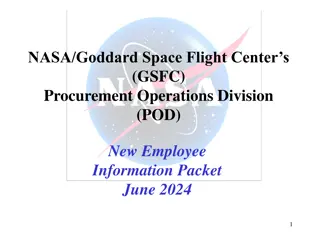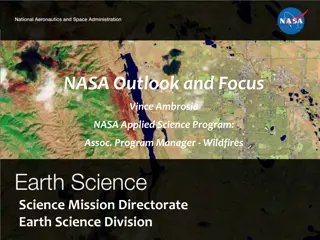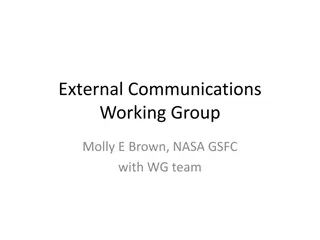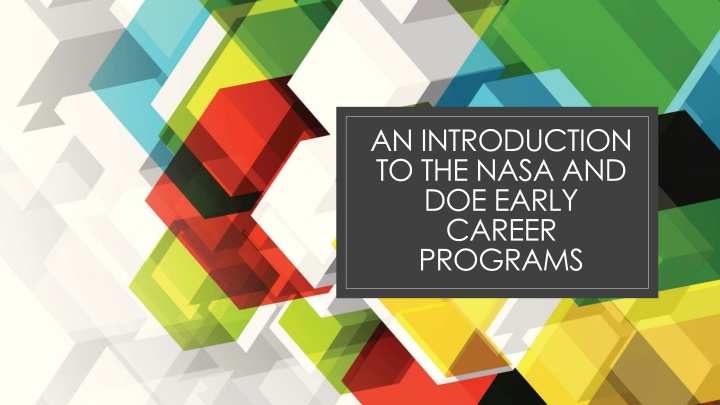
Opportunities in NASA and DOE Early Career Programs
Explore the opportunities in the NASA and Department of Energy (DOE) Early Career Programs, including an overview of the programs, application process, program areas, funding details, eligibility criteria, and more. Learn about the exciting prospects for early career researchers in these fields.
Download Presentation

Please find below an Image/Link to download the presentation.
The content on the website is provided AS IS for your information and personal use only. It may not be sold, licensed, or shared on other websites without obtaining consent from the author. If you encounter any issues during the download, it is possible that the publisher has removed the file from their server.
You are allowed to download the files provided on this website for personal or commercial use, subject to the condition that they are used lawfully. All files are the property of their respective owners.
The content on the website is provided AS IS for your information and personal use only. It may not be sold, licensed, or shared on other websites without obtaining consent from the author.
E N D
Presentation Transcript
AN INTRODUCTION TO THE NASA AND DOE EARLY CAREER PROGRAMS
Overview of todays session THE US DEPARTMENT OF ENERGY EARLY CAREER PROGRAM THE NASA EARLY CAREER FACULTY PROGRAM BREAKOUT PANEL SESSIONS
DEPARTMENT OF ENERGY EARLY CAREER RESEARCH PROGRAM
Before we begin 1. How many here submitted the Pre-Application for this cycle? (Nov. 20 due date) 2. How many people intend to apply in the next (2022 round)? We will cover the FOA for this year as it will most likely be similar for the next cycle as well.
Program Areas 1. Advanced Scientific Computing Research (ASCR); 2. Basic Energy Sciences (BES); 3. Biological and Environmental Research (BER); 4. Fusion Energy Sciences (FES); 5. High Energy Physics (HEP); 6. Nuclear Physics (NP); 7. Isotope R&D and Production (DOE IP); or 8. Accelerator R&D and Production (ARDAP).
Estimated Funding DOE anticipates that, subject to the availability of future year appropriates, a total of $100,000,000 in current and future fiscal year funds will be used to support awards under this FOA. Ceiling Historically, the average award for Institutes of Higher Education has been $750,000 for five years. Requests for budget amounts larger than the average require sufficient justification. Floor The minimum request for awards to Institutes of Higher Education is approximately $750,000 over five years. Note: Requested funding may vary year-by-year to accommodate the real and expected needs of the proposed research. The average Early Career Research award supports the PI, research staff under the PI s direction (including postdocs and graduate students), equipment (including fabrication), and other necessary costs (materials, supplies, and travel).
How many will they fund? DOE anticipates up to 65 awards under this FOA. Historically, there have been an average of approximately 20 national laboratory awards and 45 university awards each year.
Am I Eligible to Apply?? Cannot have received a DOE Early Career award in the past. No more than 10 years can have passed between the year you received your degee. For present year, that means no earlier than 2010. Next year, 2011. If you have multiple doctorates, it would be the date of the doctorate relevant to the proposed research. You must be an untenured Assistant Professor on a tenure track OR an untenured Associate Professor. You must be in this position as of the closing date of the FOA. Cannot participate in more than 3 competitions. (Like NSF CAREER)
If you have submitted the pre- application Pre-applications will be reviewed for responsiveness of the proposed work to the research topics identified in this FOA. DOE will send a response by email to each applicant encouraging or discouraging the submission of an application by the date indicated on the cover of the FOA. Pre-application response date is Dec. 17. Applicants who have not received a response regarding the status of their pre-application by this date are responsible for contacting the program to confirm this status. Applications that have not been encouraged by DOE will be declined without merit review. Deadline for full proposals is February 16 at 5:00 PM.
While you are waiting to hear Go back and re-read the RFA carefully to make sure you understand the review criteria. Review the mission pages again. Make sure you know what the mission goals are. Look at previous awards- abstracts available at https://science.osti.gov/early- career. Also, FSU Limited Submission database. Determine who is going to read your paper prior to submittal.
For those waiting for next year.. Plan to dive in early to determine which area you think is appropriate and plan to submit a paragraph to the technical contact to determine the appropriateness of your idea to his/her area prior to your pre-submission. Get to know the area well prior. Your proposed work MUST be responsive to the research topics. You have to get your foot in the door. Know the pre-application criteria 1. Responsiveness to the objectives of the FOA. 2. Scientific and technical merit. 3. Appropriateness of the proposed research approaches. 4. Likelihood of scientific impact. 5. Ensuring a diverse pool of applicants. You need to have relevant topic publication success. Review some pre-submissions if possible. The pre-application may not exceed three pages.
Things to remember They are looking for specific people, you need to show them that you are someone they want. Remember No co-Pis, only unfunded collaborators. No Letters of recommendation or letters from department chairs. An example of a successful proposal is available on our successful proposal database. The merit review criteria is important for both pre and full application. Particularly the relevance to the program.
DOE Panel Discussion Dr. Harrison Prosper Dr. Rachel Yohay, Kirby W. Kemper Endowed Professor of Physics Assistant Professor, Department of Physics Recipient of many DOE awards and former Panelist for DOE 2018 DOE Early Career Research Program Award Recipient
NASA EARLY CAREER AWARDS
NASA Directorates There are 4 NASA Mission Directorates: Aeronautic Research Mission Directorate (ARMD), Human Exploration and Operations Mission Directorate (HEOMD), the Science Mission Directorate (SMD) and the Space Technology Mission Directorate (STMD). Under the STMD are the Research Opportunities in Space and Earth Science (ROSES) and the Research Development Demonstration Initiative (REDDI) programs.
What are they looking for? NASA is seeking proposals that plan to pursue innovative, early-stage space technology research in the topic areas specifically enumerated in the solicitation. 2020 2019 Topic 1 Coordinated Multi-Robots for Planetary Exploration Topic 2 Advanced Plant/Food Production Technologies for Space Exploration Topic 3 Enhanced Diagnostics for Characterizing Entry Aerothermal Environments in High-enthalpy Impulse Facilities Topic 4 Micro or Nano-structuring Multi-layer Insulation Shields for Ultra- low Emissivity Topic 1 Advancing Human-robot Teams for Space Exploration Topic 2 Terrain Mapping and Processing Algorithms Topic 3 Advanced Thermal Control Materials for Exploration Spacecraft Topic 4 Intelligent Calibration of Constellations of Sensors
Who is Eligible? What is the funding? Only accredited U.S. universities are eligible to submit proposals on behalf of an untenured Assistant Professor on the tenure track at the sponsoring U.S. university at the time of award. A single, eligible Principal Investigator (PI) must lead the proposed research. Co-Investigators are not permitted. Collaborators (other than NASA civil servants/JPL) are permitted. The PI must be a U.S. citizen or have lawful status of permanent residency. Funds are up to $200k per year for up to three years.
Important Dates ECF 2020 Schedule 1. Release date: Feb. 05 2. Notice of Intent due Feb. 26 3. Proposal due April 22, 2020 4. Selection notification target August 27, 2020 5. Award target date mid-October 2020
What has been funded previously? Coordinated Multi-Robots for Planetary Exploration Elliot Hawkes, University of California, Santa Barbara Highly Mobile, Self-Anchoring Robots for Coordinated, High-Force Environmental Interaction Hannah Stuart, University of California, Berkeley Forceful Manual Manipulation with Millirobot Ensembles on Unreliable Substrates Sze Zheng Yong, Arizona State University, Coordinated Multi-robot-chain for Terrain Estimation and Exploration Advanced Plant / Food Production Technologies for Space Exploration Ying Diao, University of Illinois at Urbana-Champaign Remote Autonomous Plant Sensing for Space Exploration Enabled by Wearable Printed Electronics Tina Wang, University of Wisconsin-Madison Directed Evolution of Rubisco for Improved Carbon Dioxide Capture and Conversion Enhanced Diagnostics for Characterizing Entry Aerothermal Environments in High-enthalpy Impulse Facilities Chloe Dedic, University of Virginia Spatially-resolved Vibrational and Rotational Energy Distributions Using Ultrafast CARS for Multi-species Hypersonic Flow Characterization Christopher Goldenstein, Purdue University Ultrafast Laser Absorption Spectroscopy for Characterizing Shock-Heated Gases Raymond Spearrin, University of California, Los Angeles High-speed Infrared Laser Absorption Imaging of State Populations and Multiple Temperatures for Entry Studies Micro or Nano-structuring Multi-layer Insulation Shields for Ultra-low Emissivity Shankar Narayanan, Renselaer Polytechnic Institute Three-dimensional Hierarchical Structures as Multi-layer Insulation for Terrestrial and Space Applications
Things to consider Your research must be very closely related to their mission. They are very mission critical. Fundamental science that solves a problem they have. They need to know how your research will advance their science. They do not have program managers to talk to. When you submit, no discussion ahead of time. After you get an award, there will be a NASA scientist you will work with and you will visit the NASA center yearly. There are contacts for questions about the FOA. NASA uses a lot of jargon. You need to understand it. Your proposal needs to read and look like a NASA doc as much as possible. TRL (technology readiness level) they want to see you advancing quickly. Different than DOE s levels. Because NASA s topics differ every year, you may or may not be a good match year to year. If you see a good alignment, submit, don t wait. Once you are funded by NASA, it is easier to continue to get funding by NASA.
NASA Panel Discussion Dr. Mark Bourassa, Dr. Jeremy Owens Professor, EOAS and Director of the Center for Ocean-Atmospheric Prediction Studies Associate Professor, Earth, Ocean & Atmospheric Sciences NASA Reviewer/Panelist, 2 NASA Awards 8 NASA Awards Dr. Kourosh Shoele Dr. Michael Delp Assistant Professor, Mechanical Engineering Dean and Professor, College of Human Sciences 1 NASA Award 6 NASA Grants Awarded

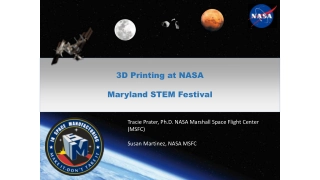

![❤Book⚡[PDF]✔ Doing the Impossible: George E. Mueller and the Management of NASA’](/thumb/21684/book-pdf-doing-the-impossible-george-e-mueller-and-the-management-of-nasa.jpg)
